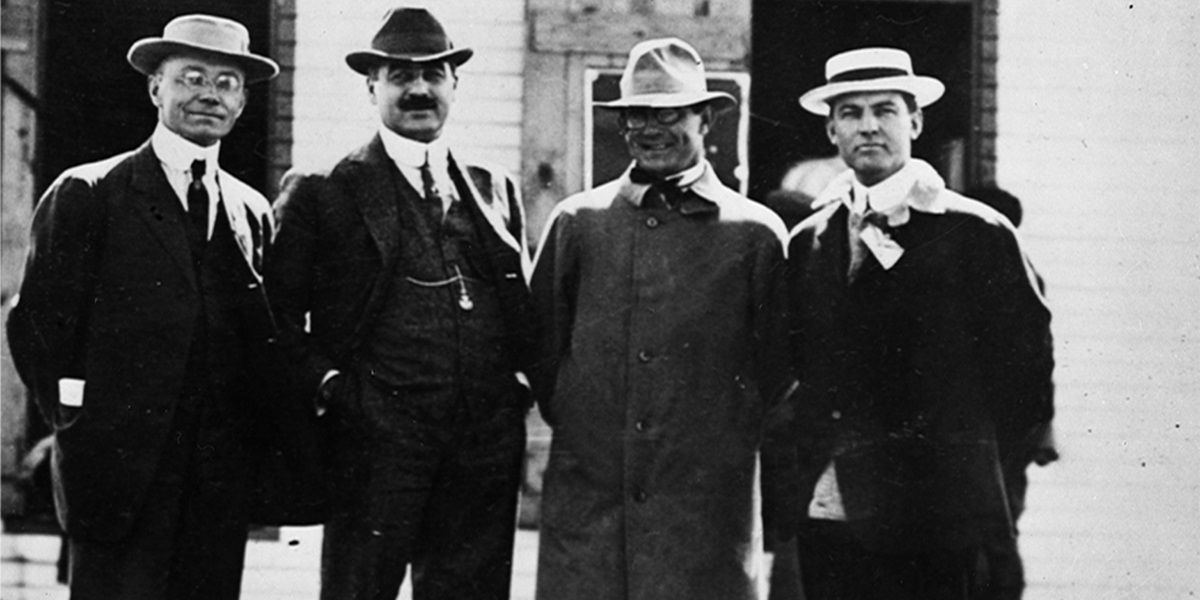
The four founding fathers of the Indianapolis Motor Speedway
March 20, 2020 | By Donald Davidson, Indianapolis Motor Speedway
CARL G. FISHER (Jan 12, 1874-July 15, 1939) was an energetic impresario who overcame poor eyesight and a meager upbringing to spearhead the building of the Indianapolis Motor Speedway in 1909. This extraordinary man also developed Miami Beach from out of swamplands; headed up the Lincoln Highway commission, which raised the funds to build the first drivable coast-to-coast highway (completed in 1928), and created the Dixie Highway.
A one-time bicycle racer from Greensburg, Indiana, who while still in his teens operated a bicycle sales and repair business in Indianapolis, Fisher entered the automotive field in 1901 as distributor for the “curved dash” Oldsmobile. In 1904, he and James Allison, who later founded Allison Engineering, put up a reported $2,500 each to manufacture automotive carbide headlamps under the name Prest-O-Lite, eventually selling the company to Union Carbide in 1917 for $9 million.
Allison joined Fisher in several ventures, including the Empire Motor Company in Indianapolis (1909), the Indianapolis Motor Speedway (with Arthur Newby and Frank Wheeler), and in 1914, the creation of the planned industrial and residential community which was eventually incorporated in 1926 as the Town of Speedway, Indiana.
Fisher, who had also been a keen balloonist and a great proponent of early-day aviation, lost virtually all of his estimated self-made $50 million fortune during the months following a hurricane which all but flattened Miami in 1926. Already heavily involved in yet another development, at Montauk Point, Long Island, his substantial investment there was lost during the attempted rebuilding of Miami and the subsequent Great Depression of the early 1930s.
Michigan-born JAMES A. ALLISON (Aug 11, 1872-Aug 3, 1928) was Carl Fisher’s principal partner in the formation (1904) of the Concentrated Acetylene Co., producer of the landmark Prest-O-Lite head lamps. In addition to being one of the four founding partners of the Indianapolis Motor Speedway in 1909, Allison joined with Fisher in the creation of Speedway City, Indiana (1914), the development of Miami Beach, and numerous other ventures. He served as president of the Indianapolis Speedway from the time Fisher stepped down on June 11, 1923 until the track was sold to the Eddie Rickenbacker group on August 15, 1927. When Fisher and Allison began preparing for the sale of Prest-O-Lite to Union Carbide in late 1914 (the sale was not completed until 1917), Allison erected a building across the street from the Speedway plant for the purpose of housing the several race cars they had acquired under the name of the Indianapolis Speedway Team Company. A series of successful machining jobs for local companies led to several major government contracts, resulting in a change of name, first to the Allison Experimental Company and shortly thereafter to the world renowned Allison Engineering Co. It was sold shortly after his death and acquired in 1929 by General Motors.
ARTHUR C. NEWBY (Dec 29, 1865-Sept 11, 1933), one of the founding partners in the Indianapolis Motor Speedway, was, at the time, the president of the National Motor Vehicle Company, producer of the National passenger car. A one-time office boy and time keeper for Nordyke & Marmon, Newby became heavily involved in the bicycle “craze” of the late 1800s, creating in 1890, the Indianapolis Stamping Company (which later became Diamond Chain) for the purpose of manufacturing bicycle chains. He helped start up the society-supported Zig-Zag Cycling Club of Indianapolis, and it was through this and his very successful Newby’s Oval, a steeply-banked bicycle racing velodrome (operating from 1898 until 1900) that he first met Fisher and Allison. He formed the National Electric Car Co in 1898 and retired from National due to ill health in December 1916. Newby, who never married, donated vast sums of money to charity during his lifetime.
FRANK H. WHEELER (Oct 24, 1864-May 27, 1921), another of the four founding partners of the Indianapolis Motor Speedway, was an outgoing Manchester, Iowa-born impresario whose principal success came after he joined forces with carburetor designer George Schebler. In spite of the success of Wheeler & Schebler (later the Wheeler-Schebler Carburetor Company), Wheeler suffered a major reversal of fortune shortly after buying out his partner to become the sole owner in 1915. He invested heavily in a 2-mile concrete speedway at Minneapolis-St. Paul which quickly failed, leading him to sell his IMS stock to Jim Allison in May 1917. While still a director of several firms, including the Stutz Fire Engine Company, despondency over a serious diabetic condition led to him taking his life on race weekend 1921. Wheeler, who built a huge palatial home next to those of Fisher and Allison on property which now comprises Marian University, may be the person responsible for advocating a Japanese-style pagoda to serve as the judges’ stand in 1913.
To read more historical content from the IMS archive about The Greatest Race Course in the World, visit IMS.com/DigitalArchive.